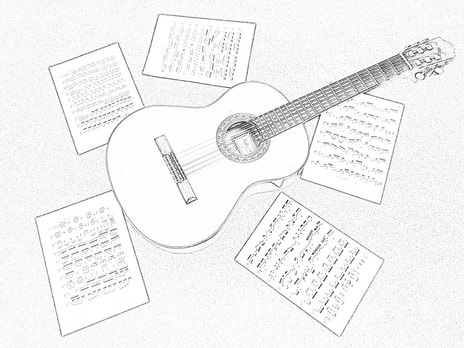
So you think you want to play the classical guitar… but you have one important question: What IS the classical guitar?
As a guitar teacher, I frequently encounter confusion from aspiring guitarists. The guitar world has become a big tent. So here’s the scoop.*
The Instrument
To the casual observer the classical guitar can look a lot like any other acoustic guitar. But look closer and you’ll notice a couple of defining traits.
The Technique
Classical guitarists pluck the strings with our fingernails or fingertips. This allows for the playing of multiple notes at the same time on non-adjacent strings.
We usually sit with the guitar on the left leg with some form of footstool or supporting cushion elevating the guitar. This allows for better ergonomics and access to the full fretboard.
The Musical Literacy
Classical guitarists learn to read music! We are able to sight read music from standard notation, and we understand the why and how of what makes things sound the way they do. We also spend plenty of time training our ears to identify notes and intervals. The more musically literate a guitarist is, the more musical opportunities she or he can take advantage of.
The Repertoire
Classical guitarists are lucky! We have several centuries of pleasing repertoire written for our instrument. In addition, arrangements of music originally written for other instruments can sound great on the classical guitar. A classical guitarist can count on never running out of musical options to explore. And because of the guitar’s popularity in many genres of music, there is a rich history of arranging popular songs as solos for the classical guitar.
What I Teach
So there you have it! The classical guitar. If this is the instrument that has you excited, then I may just be the one for you!
But wait! If it's a different type of guitar playing that has stolen your heart, let's chat! I teach students from many different stylistic corners of the guitar world.
* Hold up! It is the 21st century, and there is A LOT of great diverse music in the guitar world. I also enjoy teaching elements of classical style or technique to guitarists coming from different genres. Whether you’re a bluegrass guitarist hoping to flatpick some J.S. Bach, a jazz guitarist who wants to better understand baroque counterpoint, or a rock guitarist just looking for some new ideas to make your solos pop, adding in some classical studies can be great for getting the creative juices flowing.
As a guitar teacher, I frequently encounter confusion from aspiring guitarists. The guitar world has become a big tent. So here’s the scoop.*
The Instrument
To the casual observer the classical guitar can look a lot like any other acoustic guitar. But look closer and you’ll notice a couple of defining traits.
- The classical guitar has strings made of nylon, gut, or a similar material. These are lower tension and in some ways easier to play than the metal strings on the acoustic steel-string guitar.
- The classical guitar often has a wider neck than the acoustic steel-string guitar.
The Technique
Classical guitarists pluck the strings with our fingernails or fingertips. This allows for the playing of multiple notes at the same time on non-adjacent strings.
We usually sit with the guitar on the left leg with some form of footstool or supporting cushion elevating the guitar. This allows for better ergonomics and access to the full fretboard.
The Musical Literacy
Classical guitarists learn to read music! We are able to sight read music from standard notation, and we understand the why and how of what makes things sound the way they do. We also spend plenty of time training our ears to identify notes and intervals. The more musically literate a guitarist is, the more musical opportunities she or he can take advantage of.
The Repertoire
Classical guitarists are lucky! We have several centuries of pleasing repertoire written for our instrument. In addition, arrangements of music originally written for other instruments can sound great on the classical guitar. A classical guitarist can count on never running out of musical options to explore. And because of the guitar’s popularity in many genres of music, there is a rich history of arranging popular songs as solos for the classical guitar.
What I Teach
So there you have it! The classical guitar. If this is the instrument that has you excited, then I may just be the one for you!
But wait! If it's a different type of guitar playing that has stolen your heart, let's chat! I teach students from many different stylistic corners of the guitar world.
* Hold up! It is the 21st century, and there is A LOT of great diverse music in the guitar world. I also enjoy teaching elements of classical style or technique to guitarists coming from different genres. Whether you’re a bluegrass guitarist hoping to flatpick some J.S. Bach, a jazz guitarist who wants to better understand baroque counterpoint, or a rock guitarist just looking for some new ideas to make your solos pop, adding in some classical studies can be great for getting the creative juices flowing.